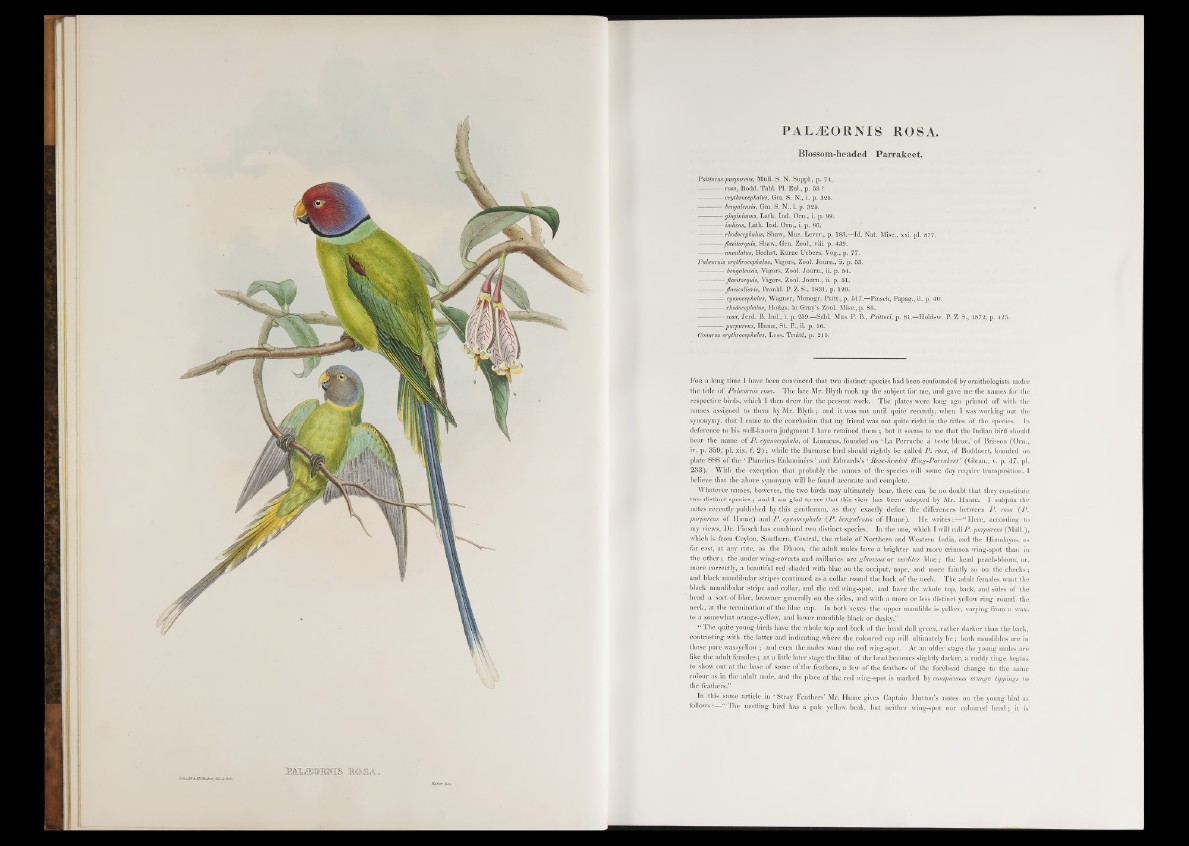
J.GmJri/A: Iff! RisJttn- ¡tel/eù h/hs
PALÆOMIS BO SA.
PALÆORNIS ROSA.
Blossom-headed Parrakeet.
Psittacus purpureus, Müll. S. N. Suppl., p. 74.
------------ rosa, Bodd. Tabl. Pl. Enl., p. 53 ?,
— erythrocephalus, Gm. S. N., i. p. 325.
------------bengalensis, Gm. S. N., i. p. 325.
— ginginianus, Lath. Ind. Orn., i. p. 99.
indicus, Lath. Ind. Orn., i. p. 86.
rhodocephalus, Shaw, Mus. Lever., p. 183.—Id. Nati Mise., xxi. pl. 877.
flavitorquis, Shaw, Gen. Zool., viii. p. 439.
------------ amulatus, Bechst. Kurze Uebers. Vög., p. 77.
Paloeornis erythrocephalus, Vigors, Zool. Joum., ii. p. 53.
bengalensis, Vigors, Zool. Journ., ii. p. 54.
------------- flavitorquis, Vigors, Zoûl. Journ., ii. p. 51.
— flavicollaris, Frankl. P. Z. S ., 1831, p. 120.
cyanocephalus, Wagner, Monogr. Psitt., p. 517.—Finsch, Papag., ii. p. 40.
rhodocephalus, Hodgs. in Gray’s Zool. Mise., p. 85,
— - rosa, Jerd, B. Ind., i. p. 259.—Schl. Mus. P. B., Psittaci, p. 81.—Holdsw. P. Z. S., 1872, p. 425.
— purpureus, Hume, St. F., ii. p. 16.
Conurus erythrocephalus, Less. Traité, p. 215.
F ob a long time I have been convinced that two distinct species had been confounded by ornithologists under
the title of Palceornis rosa. The late Mr. Blyth took up the subject for me, and gave me the names for the
respective birds, which I then drew for the present work. The plates were long ago printed olf with the
names assigned to them by Mr. Blyth ; and it was not until quite recently, when I was working out the
synonymy, that I came to the conclusion that my friend was not quite right in the titles o f the species. In
deference to his well-known judgment I have retained them ; but it seems to me that the Indian bird should
bear the name of P . cyanocephala, o f Linnaeus, founded on ‘ La Perruche a teste bleue,’ of Brisson (Orn.,
iv. p. 359, pi. xix. f. 2 ) ; while the Burmese bird should rightly be called P . rosa, of Boddaert, founded on
plate 888 of the ‘ Planches Enluminees’ and Edwards’s ‘ Rose-headed Ring-Parralceet’ (Glean., v. p. 47, pi.
233). With the exception that probably the names of the species will some day require transposition, I
believe that the above synonymy will be found accurate and complete.
Whatever names, however, the two birds may ultimately bear, there can be no doubt that they constitute
two distinct species; and I am glad to see that this view has been adopted by Mr. Hume. I subjoin the
notes recently published by this gentleman, a s' they exactly define the differences between P . rosa (P.
purpureus of Hume) and P . cyanocephala (P . bengalensis of Hume). He writes:— “ Here, according to
my views, Dr. Finsch has combined two distinct species. In the one, which I will call P. purpureus (Mull.),
which is from Ceylon, Southern, Central, the whole of Northern and Western India, and the Himalayas, as
far east, at any rate, as the Dhoon, the adult males have a brighter and more crimson wing-spot than in
the other; the under wing-coverts and axillaries are glaucous or verditer blue; the head peach-bloom, or,
more correctly, a beautiful red shaded with blue on the occiput, nape, and more faintly so on the cheeks;
and black mandibular stripes continued as a collar round the back of the neck. The adult females want the
black mandibular stripe and collar, and the red wing-spot, and have the whole top, back, and sides of the
head a sort of lilac, browner generally on the sides, and with a more or less distinct yellow ring round the
neck, at the termination of the lilac cap. In both sexes the upper mandible is yellow, varying from a wax-
to a somewhat orange-yellow, and lower mandible black or dusky.”
“ The quite young birds have the whole top and back of the head dull green, rather darker than the back,
contrasting with the latter and indicating where the coloured cap will ultimately b e ; both mandibles are in
these pure wax-yellow ; and even the males want the red wing-spot. At an older stage the young males are
like the adult females ; at a little later stage the lilac of the head becomes slightly darker, a ruddy tinge begins
to show out at the base o f some of the feathers, a few of the feathers of the forehead change to the same
colour as in the adult male, and the place of the red wing-spot is marked by conspicuous orange tippings to
the feathers.”
In this same article in ‘ Stray Feathers’ Mr. Hume gives Captain Hutton’s notes on the young bird as
f o l l o w s “ The nestling bird has a pale yellow beak, but neither wing-spot nor coloured head; it is